Tarnished Plant Bugs
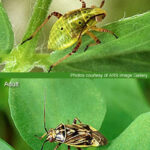 These are very common pests which are mainly seen in vegetable and floral gardens, and field crops. They are widely distributed and often encountered by many growers. One crop in which we hear of many people having a problem with them in is strawberries, in which they cause fruit abortion or disfigurement. Tarnished plant bugs, often referred to as TPB, are about six to eight millimeters long, greenish to yellow brown and have a mottled appearance. Its shape is that of an elongated shield. A close relative is the four-lined plant bug. It is distinguished by black stripes running the length of its yellow body. Supposedly, they can be controlled with predatory flower bugs like the insidious flower bug, Orius insidiosus. Other forms of control worth pursuing would be physical controls such as row covers.
These are very common pests which are mainly seen in vegetable and floral gardens, and field crops. They are widely distributed and often encountered by many growers. One crop in which we hear of many people having a problem with them in is strawberries, in which they cause fruit abortion or disfigurement. Tarnished plant bugs, often referred to as TPB, are about six to eight millimeters long, greenish to yellow brown and have a mottled appearance. Its shape is that of an elongated shield. A close relative is the four-lined plant bug. It is distinguished by black stripes running the length of its yellow body. Supposedly, they can be controlled with predatory flower bugs like the insidious flower bug, Orius insidiosus. Other forms of control worth pursuing would be physical controls such as row covers.Termites
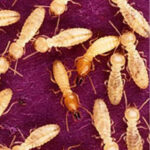 Unlike carpenter ants, termites actually consume wood. Not that this is better, or anything-the damage is just as, well, damaging. Subterranean termites, or those which make their colonies in the soil, are the focus of this discussion. They make surface tunnels which rise from the soil and terminate where the wood starts. The gray to tan, concrete-like tunnels can be found on foundations, support posts and other similar avenues of conveyance useful to termites. As a control you could keep these tunnels from forming-but this is next to impossible. Another solution would be to create a barrier of metal flashing, or diatomaceous earth or some other product which may halt their progress. Another pest control option which seems to be gaining merit is the introduction of Parasitic Nematodes around the very foundations near which these pests dwell. One thing we’ve learned, you must act before the termites start making their galleries in your structure. Once they’re in, especially if you have dampness in some of your wood, control by any of the Green Methods, may be difficult at best.
Unlike carpenter ants, termites actually consume wood. Not that this is better, or anything-the damage is just as, well, damaging. Subterranean termites, or those which make their colonies in the soil, are the focus of this discussion. They make surface tunnels which rise from the soil and terminate where the wood starts. The gray to tan, concrete-like tunnels can be found on foundations, support posts and other similar avenues of conveyance useful to termites. As a control you could keep these tunnels from forming-but this is next to impossible. Another solution would be to create a barrier of metal flashing, or diatomaceous earth or some other product which may halt their progress. Another pest control option which seems to be gaining merit is the introduction of Parasitic Nematodes around the very foundations near which these pests dwell. One thing we’ve learned, you must act before the termites start making their galleries in your structure. Once they’re in, especially if you have dampness in some of your wood, control by any of the Green Methods, may be difficult at best.Wasps (The Stinging Kind)
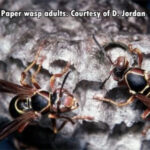 There are all sorts of wasps in this world. Most are beneficial to humans — some are so beneficial they are sold commercially by bug sellers for pest control purposes as they naturally destroy some of our worst plant pests. Try as they might to cleverly disguise their heritage by calling them parasitoids or mini-wasps or something else, the purveyors of these beneficial insects are still selling wasps. And to some of the people who listen on the other end of the telephones of these wasp-sellers, if by chance during the conversation the unaccompanied “w”-word is uttered, a real uneasiness is felt. Even though some social species eat plant pests, pollinate and are beneficial themselves in many ways, wasps, you see, have a bad name (hey, you bees, this doesn’t mean you’re completely cleared of the charges). We are stung by some wasps, they buzz us in warning, they establish fortress-like nests in which they live, love and labor in large numbers, and they invade our outdoor lives.
There are all sorts of wasps in this world. Most are beneficial to humans — some are so beneficial they are sold commercially by bug sellers for pest control purposes as they naturally destroy some of our worst plant pests. Try as they might to cleverly disguise their heritage by calling them parasitoids or mini-wasps or something else, the purveyors of these beneficial insects are still selling wasps. And to some of the people who listen on the other end of the telephones of these wasp-sellers, if by chance during the conversation the unaccompanied “w”-word is uttered, a real uneasiness is felt. Even though some social species eat plant pests, pollinate and are beneficial themselves in many ways, wasps, you see, have a bad name (hey, you bees, this doesn’t mean you’re completely cleared of the charges). We are stung by some wasps, they buzz us in warning, they establish fortress-like nests in which they live, love and labor in large numbers, and they invade our outdoor lives.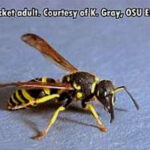
None of it would be a big deal, especially, if not for the two simple facts: they can sting us and it hurts like hell when they do. Couple those facts with the social nature of these insects, and the fear is compounded. These social wasps who sting us number few in the overall picture, though — a cross-section of wasp families will reveal but a tiny sliver of those which can be classified as such. The majority are innocuous (to humans) and solitary in their ways. Bald-faced hornets, yellowjackets, paper wasps (ordered from least-favorite to most), and others all live socially and can hurt us with their stingers — which are, by the way, ovipositors, or egg-laying apparatus, which have been modified as weapons capable of injecting a pain- and swelling-causing toxin. But they only sting when they feel threatened. And since their nests are often in close proximity to the places we live and journey, we often have confrontations. The Green Methods would not instruct one to employ one of those spray cans which project their entire contents twenty feet in a mere thirty seconds. The Green Methods would suggest instead, as one alternative, to physically remove the nest while the wasps are still occupying the structure. There’s no foolishness here, though. If possible, use a hose to blast the nest with cold water — which, if it doesn’t numb the wasps, may actually detach the nest from its location. Next, if it looks safe enough and the if water pressure didn’t do the trick, use a broom or something to knock the nest back to wherever it came from. Oh, and then run like mad, but be careful, it’ll be dark out; or at least it should be when you do all this. Pick a cool night, too, as the wasps will be less active.
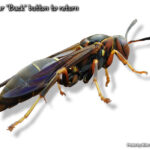
In some cases the nests are built in the ground protected by root structures or rocks and can’t be disturbed. Alternative Green Methods will be needed. Methods may include tainting dog food with Parasitic Nematodes in hopes of summer foraging wasps (meat-eaters) may bringing some nematodes back with the food to kill the brood. Or, perhaps, drizzling honey by the nest’s opening at night in hopes of tempting some mammal, like a skunk, to do your bidding for you and rip apart the wasps’ lair. All too much for you? A little closer to convention, there are simple traps available for yellowjackets — especially when they are after sweets later in the season. If all this fails, live with them, create another clever alternative Green Method, or don’t bother them so they won’t bother you.
Update: We have heard that the “safe” cleaner Simple Green, in its concentrated form, will knock down yellow jackets and paper wasps as fast as the heavy duty chemicals discussed above. To learn more about dealing with wasps, especially in the fall, check out this article in our blog.
Webworms & Tent Caterpillars
 Once again moths reveal their obvious dislike of our trees. These pests, the larvae of several moth species, generally speaking, share a similar life-style. The adults lay eggs, the eggs hatch, the larvae feed and form protective webs as they do so, then pupate to adulthood to repeat the process. There are some differences, though. Webworms overwinter as pupae in the soil or leaf litter, while tent caterpillars overwinter as adults. Moreover, tent caterpillars will leave the web/tent to feed. Webworms affect many varieties of trees, shrubs and plants. Their adult forms range in color from white to tan, and in size from fifteen millimeters to two centimeters. All are nondescript. Tent caterpillars are roughly the same size and are also plain in their appearance. Despite any differences, however, the control techniques, with little variation, remain the same. Bacillus thuringiensis (K) (Bt) variety Kurstaki works on both groups of the pests’ larvae. Removing and destroying the webs or tents — the ones you can reach — can reduce populations. Trichogramma spp. moth-egg parasitoids may help if timing of releases coincides with the presence of the moths’ eggs. To attract or release spined soldier bugs, Podisus maculiventris, may also help lessen the larval populations. And finally, for the webworms, anyway, Parasitic Nematodes may attack the pupae.
Once again moths reveal their obvious dislike of our trees. These pests, the larvae of several moth species, generally speaking, share a similar life-style. The adults lay eggs, the eggs hatch, the larvae feed and form protective webs as they do so, then pupate to adulthood to repeat the process. There are some differences, though. Webworms overwinter as pupae in the soil or leaf litter, while tent caterpillars overwinter as adults. Moreover, tent caterpillars will leave the web/tent to feed. Webworms affect many varieties of trees, shrubs and plants. Their adult forms range in color from white to tan, and in size from fifteen millimeters to two centimeters. All are nondescript. Tent caterpillars are roughly the same size and are also plain in their appearance. Despite any differences, however, the control techniques, with little variation, remain the same. Bacillus thuringiensis (K) (Bt) variety Kurstaki works on both groups of the pests’ larvae. Removing and destroying the webs or tents — the ones you can reach — can reduce populations. Trichogramma spp. moth-egg parasitoids may help if timing of releases coincides with the presence of the moths’ eggs. To attract or release spined soldier bugs, Podisus maculiventris, may also help lessen the larval populations. And finally, for the webworms, anyway, Parasitic Nematodes may attack the pupae.Wireworms
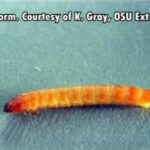 The larvae of click beetles are familiar creatures to many gardeners and nurserymen. The adults, though, are largely unknown as they are unremarkable and seldom seen. Moreover, they cause little to no damage to the plants they feed on, which definitely helps the limelight shift away from them. The destructive worms are orange in color, about three centimeters in length, and are clearly segmented. They, unlike their parents, are very destructive as they bore into modified roots such a tubers, bulbs, rhizomes and corms. The most unusual characteristic of the click beetle’s larva is the fact it stays as a larva for several years instead of undergoing a complete metamorphosis at least once annually. This, however, makes targeting them a little more straightforward as you won’t have to be so concerned with timing — as is the case with most other beetles worthy of larval control techniques. In most those cases Parasitic Nematodes were used with satisfactory results. Additional control may be obtained from azadirachtin, the active ingredient in neem-based products.
The larvae of click beetles are familiar creatures to many gardeners and nurserymen. The adults, though, are largely unknown as they are unremarkable and seldom seen. Moreover, they cause little to no damage to the plants they feed on, which definitely helps the limelight shift away from them. The destructive worms are orange in color, about three centimeters in length, and are clearly segmented. They, unlike their parents, are very destructive as they bore into modified roots such a tubers, bulbs, rhizomes and corms. The most unusual characteristic of the click beetle’s larva is the fact it stays as a larva for several years instead of undergoing a complete metamorphosis at least once annually. This, however, makes targeting them a little more straightforward as you won’t have to be so concerned with timing — as is the case with most other beetles worthy of larval control techniques. In most those cases Parasitic Nematodes were used with satisfactory results. Additional control may be obtained from azadirachtin, the active ingredient in neem-based products.